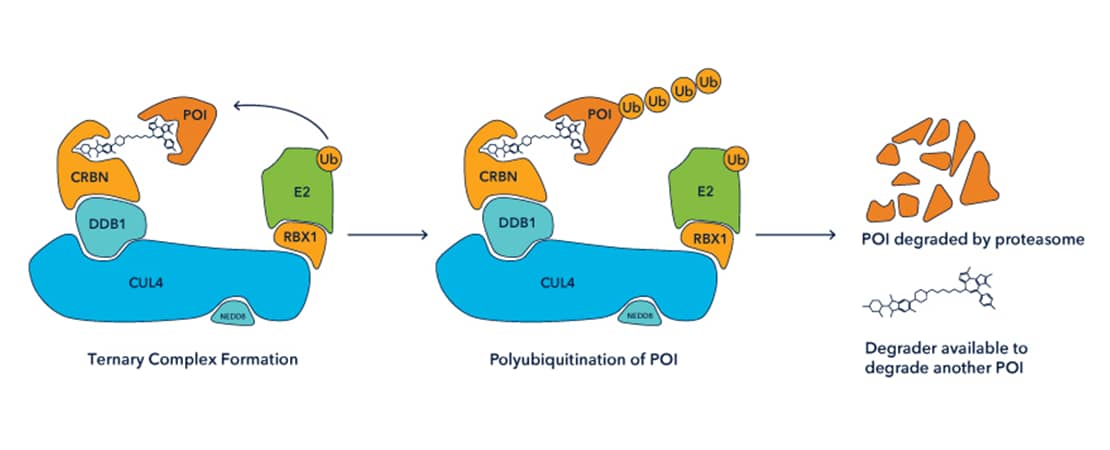蛋白质降解剂
靶向蛋白降解需要使用蛋白质降解剂,以在翻译后实现靶蛋白的强效和选择性敲减。 使用小分子双功能降解剂敲减靶蛋白的多种方式不断涌现,例如处于该领域前沿的 PROTAC® 分子、SNIPER、PHOTAC、Degronimids 和 uSMITEs™。
Bio-Techne 提供广泛的蛋白质降解剂和阴性质控品,以帮助您研究您关注的靶点。
What are Small Molecule Protein Degraders?
Protein Degraders are bifunctional compounds comprising 3 components: an E3 ubiquitin ligase ligand, a linker, and a ligand for a target protein of interest. They induce the formation of a ternary complex by simultaneously binding to both an E3 ligase and target protein. Ternary complex formation effectively ‘hijacks’ the E3 ligase to polyubiquitinate a target of interest, inducing subsequent degradation by the 26S proteasome.
Degraders are attractive tools for use in basic research to induce selective protein knockdown in a reversible and tuneable manner, without the requirement for genetic modification to cells. Degraders also have therapeutic potential as an approach to target the ‘undruggable’ proteome and overcome common resistance mechanisms to current therapies.
The PROTAC® concept was first described in 2001. The first generation of Degraders synthesized were peptide-based and were not cell-permeable, however they demonstrated the principle that it is possible to direct an E3 ligase to degrade a protein of interest. The first small molecule protein Degraders were also reported by Craig Crews’ group in 2008. Since then, a wide range of degraders have been synthesized, recruiting different E3 ligase enzymes, including Cereblon, von Hippel Lindau (VHL) and inhibitor of apoptosis (IAP), and targeting a variety of protein targets, such as enzymes, receptors, bromodomains and transcription factors.


图 2:Wes 数据显示 MOLT-4 细胞经过 200 或 500 nM THAL SNS 032(目录编号 6532)处理后,CDK9 亚型均被敲减。蛋白定量(与仅使用 DMSO 的质控品相比)显示在相应行下方。
实验由 Simple Western™ 应用科学团队进行。Simple Western 全自动 Western Blot 系统提供定量数据,从而可以准确测定蛋白质降解剂的 DC50 和 Dmax 值。
蛋白质降解剂的优势
蛋白质降解剂可方便替代 RNAi 和 CRISPR 等基因编辑方法,实现蛋白质敲减。一些优势总结如下:
- 降解剂使用方便快捷。它们可直接应用于细胞,无需表达载体或转染。
- 可通过改变所使用的降解剂剂量,轻松调节蛋白质降解水平。
- 降解剂可广泛用于不同的细胞系,因为它们不要求细胞必须易于转染。
- 降解剂的作用可在洗脱时逆转,因此作用持续时间易于控制。
- 降解剂能够以亚化学计量浓度使用,可产生显著和持续的作用(源自其催化作用模式)。与小分子抑制剂相比,降解剂可提供更强的选择性。例如,PROTAC® 分子 AT 1(目录编号 6356)是 BRD4 的选择性降解剂,而 AT 1 的靶蛋白配体组分 (+)- JQ1(目录编号 4499)还能抑制密切相关的 BET 溴结构域家族其他蛋白。
使用蛋白质降解剂
降解剂的活性由 DC50 和 Dmax 值表示。DC50 用于衡量效力,是 50% 靶蛋白降解时的降解剂浓度;相当于抑制剂的 IC50。Dmax 是可达到的最大降解水平。这些值可提供有效指导,以确定在实验中使用的降解剂的适当浓度。不同降解剂实现最大降解的时间存在显著差异,在计划实验时也应加以考虑。
很低的降解剂浓度即可实现靶蛋白的有效敲减。某些情况下,在较高剂量下,降解剂表现出“钩状效应”。该效应是指在降解剂浓度较高时,二元复合物的形成增加,与三元复合物的形成产生竞争,导致降解效率降低。

图3:此 Western Blot 表现出所谓的“钩状效应”,显示了降解剂介导的重组 BRD4 的多聚泛素化。CRBN E3 连接酶复合物(目录编号 E3-650)用于研究降解剂诱导的重组 FLAG 标记 BRD4((目录编号 SP-600)的体外多聚泛素化。结果使用抗 FLAG Western Blot 分析。底物的泛素化程度随反应中使用的降解剂浓度而变化。
分子胶
分子胶是一种小分子蛋白二聚体,通过与 PROTAC® 降解剂类似的机制,实现靶向蛋白降解。然而,分子胶不是嵌合分子。分子胶通过与靶蛋白和 E3 连接酶形成三元复合物来发挥作用,这能导致蛋白质的泛素化,然后被蛋白酶体破坏降解。分子胶与 E3 连接酶相互作用可导致 E3 连接酶结合位点的别构修饰,使得其不能结合天然底物,从而能够与目标蛋白(或新底物)形成三元复合物。与其他小分子蛋白降解剂一样,分子胶也具有催化作用。
Background Information
- LYTAC(LYsosome TArgeting Chimera molecule,溶酶体靶向嵌合体分子):LYTAC 将胞外目标蛋白转运至溶酶体中进行降解,由威斯康星大学发明。
- PROTAC®(PROteolysis TArgeting Chimeric molecule,蛋白水解靶向嵌合分子):这一术语在 Craig Crews 实验室(耶鲁大学)2001 年的一篇论文中提出,现被广泛用于指代蛋白降解剂分子。
- SNIPER(Specific and Nongenetic Inhibitor of apoptosis protein (IAP)-dependent Protein ERaser,特异性和非遗传性凋亡蛋白抑制剂 [IAP] 依赖性蛋白擦除剂):SNIPER 专门募集 E3 连接酶 IAP,由东京大学开发。
- PHOTAC(PHOtochemically TArgeting Chimera,光化学靶向嵌合体):这些是可由不同波长的光激活的光开关降解剂,由纽约大学开发。
- uSMITE™(Ubiquitin-mediated, Small Molecule-Induced Target Elimination technology,泛素介导的小分子诱导靶标消除技术):由 Cullgen 开发的一种降解剂。
-
Itoh, Y et al. (2010) Protein knockdown using methyl bestatin-ligand hybrid molecules: design and synthesis of inducers of ubiquitination-mediated degradation of cellular retinoic acid-binding proteins. J. Am. Chem. Soc . 132:5820. PMID: 20369832.
-
Reynders, M et al. (2020) PHOTACs enable optical control of protein degradation. Sci. Adv. PMID: 32128406.
-
Rodriguez-Gonzalez, A et al. (2008) Targeting steroid hormone receptors for ubiquitination and degradation in breast and prostate cancer. Oncogene . PMID: 18794799.
-
Sakamoto, K et al. (2001) Protacs: chimeric molecules that target proteins to the Skp1-Cullin-F box complex for ubiquitination and degradation. Proc. Natl. Acad. Sci. USA PMID: 11438690.
-
Schneekloth, A et al. (2008) Targeted intracellular protein degradation induced by a small molecule: En route to chemical proteomics. Bioorg. Med. Chem. Lett. PMID: 18752944.
PROTAC® 是 Arvinas Operations, Inc.的注册商标,经许可使用。